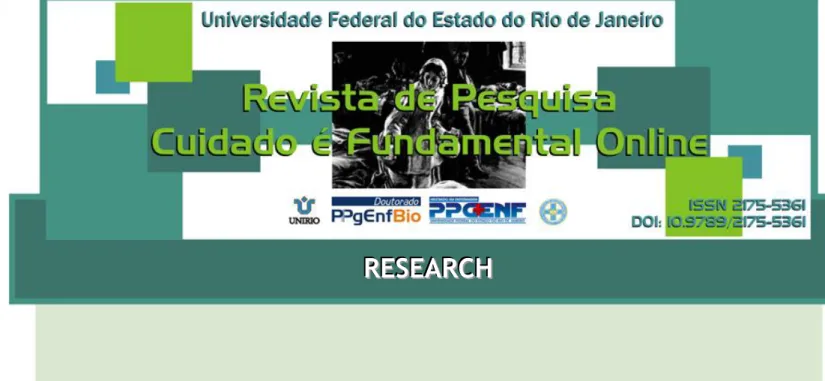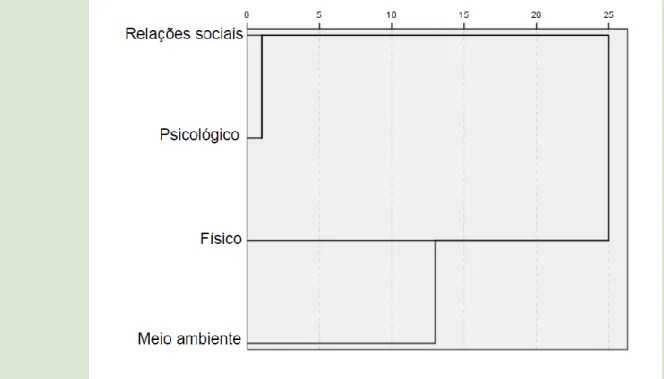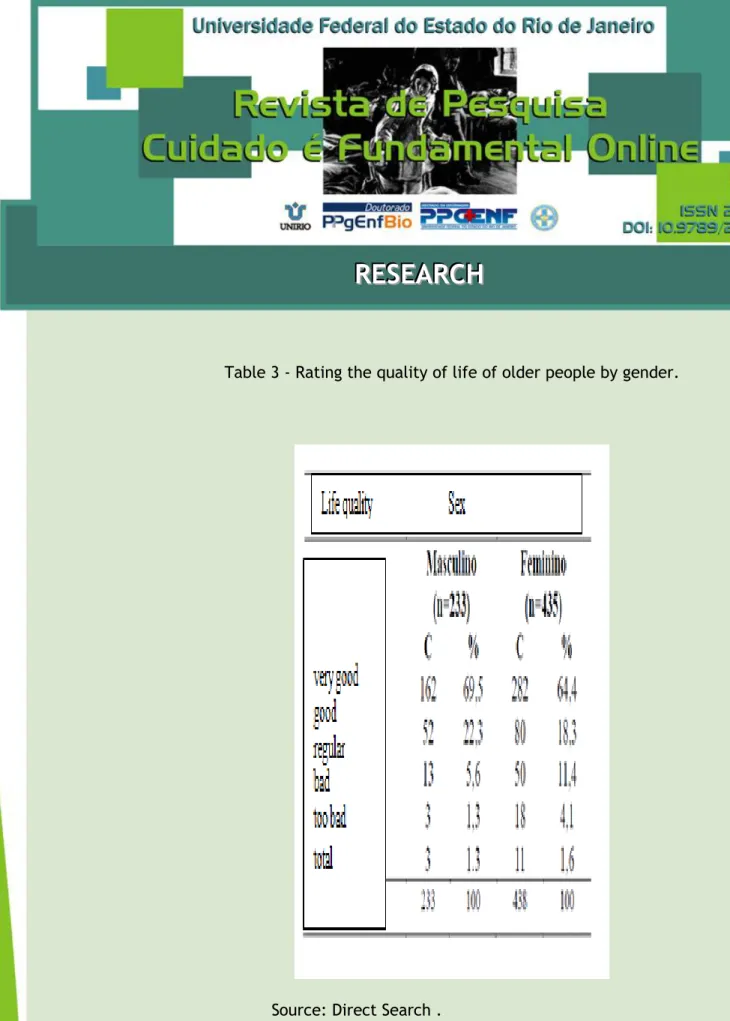J. res.: fundam. care. online 2015. jan./mar. 7(1):2021-2033
2021
Quality of life of elderly people attended by the Family Health StrategyCalidad de vida de las personas mayores atendidas em la Estrategia de Salud Familiar
Olga de Fátima Jansen dos Santos1, Maria do Carmo de Carvalho e Martins2, Maria Helena Barros de Araújo Luz3, Cristina Maria Miranda de Sousa4
Objective: To assess the quality of life of elderly people assisted by the Family Health Strategy. Method:
Cross-sectional, descriptive-exploratory and quantitative study conducted at the homes of elderly people in the urban area of Floriano – PI. The sample was composed of 671 elderly people. Data were collected by using WHOQOL-Bref and a questionnaire for social-demographic information. The data were processed with the Chi-square test and analysis of hierarchy grouping. Results: The majority of the study was composed of females (65.3%). Most of the elderly people surveyed lived without a spouse, with monthly income ranging between 1 and 3 minimum salaries and had very good quality of life (66.2%). Most of the latter were males (69.5%), with significant difference between genres (p=0.021). Conclusion: The majority of the elderly people surveyed had good quality of life according to scores from the dominions evaluated by WHOQOL-Bref, showing higher scores in the dominion of social relationships and lower scores in the dominion of environment. Descriptors: Elderly, Quality of life, Family Health Strategy.
Objetivo: Avaliar a qualidade de vida de idosos inseridos na Estratégia Saúde da Família. Método: Estudo
transversal, descritivo-exploratório, quantitativo, realizado nos domicílios de idosos da zona urbana do município de Floriano – PI. A amostra constituiu-se por 671 idosos. A coleta de dados foi realizada utilizando o WHOQOL-Bref e um questionário para obtenção de informações sociodemográficas. As associações foram realizadas por testes Quiquadrado e análise de agrupamento hierárquico. Resultados: Houve predominância do sexo feminino (65,3%). A maioria dos idosos vivia sem companheiro, no âmbito familiar, com renda mensal de 1 a 3 salários mínimos e possuía qualidade de vida muito boa (66,2%), sendo maior proporção para o sexo masculino (69,5%), com diferença significativa entre os sexos (p=0,021).
Conclusão: A maioria dos idosos pesquisados possuía boa qualidade de vida segundo os escores dos
domínios avaliados pelo WHOQOL-Bref, apresentando maiores escores para o domínio das relações sociais e menor para o domínio meio ambiente. Descritores: Idosos, Qualidade de vida, Estratégia Saúde da Família
Objetivo: Evaluar la calidad de vida de ancianos inseridos en la Estrategia Salud de la Familia. Método:
Estudio transversal, descriptivo-exploratorio, cuantitativo, realizado en los domicilios de ancianos de la zona urbana del municipio de Floriano – PI. La muestra se constituyó por 671 ancianos. La recolección de datos fue realizada utilizando el WHOQOL-Bref y un cuestionario para obtención de informaciones sociodemográficas. Las asociaciones fueron realizadas por tests Chiquadrado y análisis de agrupación jerárquica. Resultados: Hubo predominancia del sexo femenino (65,3%). La mayoría de los ancianos vivían sin compañero en el ámbito familiar, con renta mensual de 1 a 3 salarios mínimos y poseían calidad de vida muy buena 66,2%, siendo mayor proporción del sexo masculino (69,5%), con diferencia significativa entre los sexos (p=0,021). Conclusión: La mayoría de los ancianos investigados poseía buena calidad de vida según las frecuencias de los dominios evaluados por el WHOQOL-Bref, presentando mayores frecuencias para el dominio de las relaciones sociales y menor para el dominio medio ambiente.
Descriptores: De edad, Calidad de vida, Estrategia Salud de la Familia.
1 Nurse. Master in Family Health at University Center UNINOVAFAPI. Teresina (PI), Brazil. Email: olgafpj@hotmail.com 2Nutritionist. PhD in Biological Sciences from the Federal University of Pernambuco. Associate Professor of the Department of
Biophysics and Physiology, Federal University of Piauí. Professional Master Professor in Health University Center Family UNINOVAFAPI. Teresina (PI), Brazil. Email: mcmartins@uninovafapi.com.edu.br 3 Nurse. PhD in Nursing from UFRJ. Professor of the Graduate Program and the Graduate Nursing UFPI. Teresina (PI), Brazil. Email: mhelenal@yahoo.com.br 4 Lawyer. PhD in Health Sciences, Federal University of Rio Grande do Norte (UFRN). Professional Master Program Professor in Health University Center Family UNINOVAFAPI. Teresina (PI), Brazil. Email: cristinamiranda@uninovafapi.edu.br
ABSTRACT
RESUMEN RESUMO
R. pes.: cuid. fundam. online 2015. Jan./mar., 7(1):2021-2033
2021
F
or a long time grew up in Brazil the idea that this was a young country, however, is currently considered elderly, twenty-one million people aged more than sixty years, which corresponds to 11% of the population national. The forecast for 2020 is a population of thirty million elderly, which represent 13% of the population in the country. In 2010, the number of people in Piauí aged 60 or more was 331,772, which corresponds to 11.4% of the state population and the city of Floriano, located 240 km from the capital, had 6,439, corresponding to 11, 16% of the population.1
The growing number of elderly in the country has generated social impact, drawing attention of society to public policies for the elderly. From the perspective of an aging population, studies have shown that these are major users of health services and many are affected by diseases or injuries that require monitoring, which, though not fatal, tend to compromise the quality of life.2 In Brazil assessing the population's quality of life has been used in place of traditional health indicators. The number of publications found in journals, including those in the health field, has been increasing since the 1970s There is now a tendency to evaluate the quality of life based on the specific aspects associated with different groups of individuals with certain diseases or idade.3 same evaluation criteria are valued from the way of thinking of each individual, based on the circumstances in which they find themselves, including physical, psychological, social, cultural and spiritual. For this reason, have been proposed different scales for assessing specific quality of life for certain stocks of indivíduos.4
The concept of quality of life depends on the socio-cultural level and the personal aspirations of each, as well as being related to self-esteem and personal well-being, which depend on aspects such as functional capacity, economic, psychosocial level, intellectual activity, values cultural, ethical and religious, health status and satisfaction in their activities desenvolvidas.4
The public policy of the Family Health Strategy (FHS), facing the elderly allows the knowledge of social conditions and health of the elderly, thereby potentially 30 results to promote improvement of functional capacity, disease prevention and health recovery providing healthy aging. It is understood that the problems encountered in this phase of life have specific characteristics that need to be addressed, preferably in the community, ie, the area in which it operates the ESF. Assess the elderly
R. pes.: cuid. fundam. online 2015. Jan./mar., 7(1):2021-2033
2022
METHOD
living conditions allows the implementation of proposals that address the general social policies in order to promote well-being in senescência.5 Considering the lack of studies related to the evaluation
of quality of life and socio-demographic profile of the elderly in Piauí mainly within the state, this study evaluated the quality of life of elderly treated in Floriano municipality of ESF in search of bigger and better understanding of the conditions in which older people live.
This is a cross-sectional, descriptive and exploratory study with a quantitative approach. The study was conducted in the homes of elderly enrolled in the Family Health Strategy (FHS) in the city of Floriano, Piauí. That city has 24 teams ESF, of which 17 are located in urban areas and 7 in the countryside. The population of elderly enrolled in the urban area is 5,905 people. The sample used in the study was proportional stratified random type and composed of 671 individuals. In calculating the sample size was considered a confidence level of 95% and finite population of 5,905, according to the formula used to estimate the proportion of large samples, 6 with an error margin achieved 3.6%.
The inclusion criteria were not present cognitive deficit or frames that prevented answer questions. The instrument used for data collection was the WHOQOL-BREF, which evaluated socioeconomic conditions and the quality of life for seniors. This is an international instrument, validated for use in the elderly in Brazil.7 was developed by a group of experts in quality of life of the World Health Organization (WHO) and translated by the Federal University of Rio Grande do Sul8 in order to assess the quality of life of individuals from information related to different aspects of life.
The WHOQOL-BREF is a shortened version of WHOQOL-100 that was developed for fast application, composed of 26 questions. The first question relates to the quality of life and the second question to the satisfaction of their own health. The other 24 are divided into 31 domains physical, psychological, social relationships and environment. Each domain consists of questions whose scores range from 1 to 5.3 was also applied in the research, a sociodemographic questionnaire, developed by the researcher to obtain information on age, marital status, study time, retirement, housing, who they live and income monthly family. Data collection was conducted from March to August 2012. This was requested from the Municipal Health Floriano the ratio of elderly enrolled in the ESF the village and
R. pes.: cuid. fundam. online 2015. Jan./mar., 7(1):2021-2033
2023
RESULTS AND DISCUSSION
conducted a simple random selection proportional to the number of elderly assisted by FHS teams in each UBS. Data were collected at the homes of the study subjects.
The data obtained in the study were from the answers to the questionnaire and the elderly were exposed in tables and graphs. Statistical analysis was performed using the Statistical Package for the Social Sciences (SPSS), version 15.0, performing comparison of means of age, the scores of the domains of quality of life between males and females. Associations were performed using chi-square test (χ2) and was also performed hierarchical cluster analysis. The level of significance was set at p <0, 05.
The study was approved by the Research Ethics Committee of the University Center UNINOVAFAPI, opinion number 0440.0.043.000-11. All ethical principles contained in Resolution 196/96 of the National Health Council were followed.
Table 1 presents aspects related to socio-demographic characteristics of respondents elderly. It was observed that most elderly (65.3%) analyzed were female. The survey also revealed that a high proportion of elderly were in the age group 65-69 years (22.4%) lived without a partner (57.2%) and had only 1-4 years of education (47.7 %). The elderly subjects were, for the most part, retired (86.9%) and more than half (53.8%) had a family income between two and three minimum wages. The analysis also showed that the elderly lived with their families, having their own house (90.9%), with treated water (98.7%) and electricity (99.7%).
According to sociodemographic characteristics of respondents elderly stratified by gender, the data obtained from the study revealed that 24.9% of elderly men were aged 70-74 years and 22.8% of older women were in the range 32 age of 60-64 years. The survey also showed that 81.5% of elderly men living without a partner, while for the more than half female (55.7%) lived with a partner. The income of elderly men was significantly higher than that of females (p <0.05), and less than two minimum wages in females (48.6%).
R. pes.: cuid. fundam. online 2015. Jan./mar., 7(1):2021-2033
2024
Table 1 - Distribution of elderly people assisted in the Family Health Strategy (FHS) in the urban area of the city of Floriano, Piauí, according to sociodemographic characteristics.
R. pes.: cuid. fundam. online 2015. Jan./mar., 7(1):2021-2033
2025
The dendrogram shown in Figure 1, obtained by hierarchical clustering of domain scores for quality of life "WHOQOL-bref" converted to 0-100 scale in the physical, psychological, social relationships and environment, revealed two distinct groups. The first consists of the psychological domain with the domain of social relations, as they showed great similarity according to the values of their scores for population surveyed elderly. This shows that social relations are closely linked to psychological issues. The second group got the physical domain, which showed a close relationship with the environment domain due to the similarities of the scores achieved for both domains. This similarity strengthens the physical domain is interconnected with the environment domain.
Figure 1 - Dendrogram the relationship between physical, psychological, social relationships and environment.
In Table 2, there was comparison of the old and the scores of the domains of quality of life between males and females. The results showed statistically significant differences (p <0.05) between the averages of the scores in the physical and psychological, higher for male and female domains.
R. pes.: cuid. fundam. online 2015. Jan./mar., 7(1):2021-2033
2026
sex.Source: Direct Search
Regarding the quality of life score (Table 3), the overall prevalence of very good quality of life was 66.2% and 3.1% bad, with the highest proportion of very good for males (69, 5%) and bad for females (4.1%), with statistically significant differences between the sexes (p = 0.021).
R. pes.: cuid. fundam. online 2015. Jan./mar., 7(1):2021-2033
2027
Table 3 - Rating the quality of life of older people by gender.Source: Direct Search .
χ2 = 11,535a; at p = 0.021. 1 cell (10%) have lower life expectancy than 5. The minimum expected expectation is 3.82. N: number of older adults considered extract; C: number of cases.
Table 4 presents the classification of the quality of life in accordance with income. For most patients (66.2%), quality of life was considered very good, with a higher proportion (69.9%) for seniors with incomes ≥2 minimum wages.
R. pes.: cuid. fundam. online 2015. Jan./mar., 7(1):2021-2033
2028
Table 4 - Quality of life * Rating elderly according to income and age.Source: Direct Search
* χ 2 = 10,493a; p = 0.033 1 cell (10%) have lower life expectancy than 5. The minimum expected expectation is 4.62. $ χ2 = 18,960a; p = 0.001 a.1 cell (10%) have lower life expectancy than 5. The minimum expected expectation is 4.77.
R. pes.: cuid. fundam. online 2015. Jan./mar., 7(1):2021-2033
2029
proportion for older people under 70 years of age (17.9%). It is noteworthy that 9.4% of the surveyed subjects had regular quality of life and most were aged below 70 years (11.8%). The largest proportion of the elderly aged 70 or more (3.4%) had poor quality of life (3.1%). In all cases analyzed were significant differences among the elderly aged <70 years and ≥70 years (p = 0.001).
The elderly studied are mostly female (65.3%), feature also found in other studies conducted in Brazil showed that the country has a ratio of 100 women for 82 elderly men .1 It is estimated that women live approximately seven years longer than men and tend to have problems with long, chronic and disabling periods, while older men develop fatal diseases and short duração.9 There was a predominance in the age group of 70-74 years for males (24.9%). Lower percentage was obtained in a survey of elderly residents in Juiz de Fora / MG.2 Regarding marital status, 57.2% of seniors surveyed
lived without partners. Research conducted shows that not having a partner may be related to the fact that loneliness is a social condition that weakens the health, encouraging introspection and worse perception with regard to the condition física.10 Further research showed that not having a partner is related to low level quality of life.11
Considering the fact that the majority of the elderly live with family (89.9%) in own home (90.9%), it was observed that it is essential the inclusion of the elderly family households with several generations, benefiting family relationship, reducing isolation and promoting the quality of life.12 Of the surveyed elderly, 47.7% had less than 4 years of study. This percentage is lower than that reported for the population of Northeast elderly, who owned 52.2% of seniors with less than 4 years of schooling and are considered illiterate funcionais.1
Seniors surveyed, the vast majority were retired (86.9%). Retirement should be thought of as an opportunity for new escolhas.13 The labor activity, the psychological perspective, is an affirmation of
self-esteem and occupation of a role in society. With the end of occupation, other factors eventually become extinct as the magnitude of social relations, recognition by the profession and the reference in the work, which results in the feeling of powerlessness and exclusion of the elderly in sociedade.14
Regarding family income, 96% of the elderly in the urban area of the municipality had Floriano income 1-3 times the minimum wage. However, this data reflects not only the elderly income, which suggests that the family can be financially supported by this. Most elderly Brazilians live with a minimum wage, which is the most common retirement amount paid to the population idosa.5 In Brazil 22.9% of the elderly had higher yields than 2 minimum wages and 43.2% by 1 salário.1 There was no influence of equity in any of the areas of quality of life.
The study found that the elderly had good quality of life scores for all domains of the WHOQOL-Bref, regardless of sex, when compared to the maximum the scores for each domain and the
R. pes.: cuid. fundam. online 2015. Jan./mar., 7(1):2021-2033
2030
averages found for the different domains of quality of life in the population studied. Socio-demographic variables such as gender, family income, age, education did not influence the quality of life of the aged. However, when it was found the sex ratio for the physical, psychological and environmental domains, the scores of these domains were significantly higher for elderly men. Research highlighted the sex relationship to quality of life, pointing a highlight for sex masculino.15-16 The elderly males had
very good quality of life. The scores in the physical domain of quality of life were more significant in the elderly this sexo.17 female Seniors are more prone to physical and mental problems. This
corroborates with lower scores in the field psicológico.18 There was no significant relationship between age and the studied areas. For men and women is relevant to physical, functional maintenance and emotional well-being with advancing age, resulting in the balance between the various dimensions of the functional capacity of the elderly, without necessarily mean absence of problems in all dimensões.19
In this study, the environmental domain had lower quality of life scores in males (55.9%), without statistical significance, configured as the lowest average of the four areas, which may be related to the few recreational opportunities and entertainment difficulties in the community. The elderly in the urban area of the city of Floriano, for the most part, showed good quality of life for 39 possess either villa with treated water, electricity, and are mainly within the family.
Only the psychological domains and social relations reached which shows a good or very good quality of life of the elderly, which can be linked to other areas, also considered good and greater than 50%. The psychological and social domains are reported in several studies as relevant to the quality of life of idosos.20
Due to the great importance of the study of quality of life, it is therefore necessary to conduct further studies to enable check other factors that can influence the quality of life of the elderl
J. res.: fundam. care. online 2015. jan./mar. 7(1):2021-2033
2031
REFERENCES
assessment of the same was observed, showing that the majority had a very good quality of life (66.2%). The results showed better scores for the field of social relationships and less to the domain environment. Due to the relevance of the study of quality of life of the elderly, it is expected that the research will help health professionals and the public in general with regard to the health of the elderly and the aging process.
1.Instituto Brasileiro de Geografia e Estatística - IBGE. Síntese de indicadores sociais: uma análise das condições de vida da população brasileira 2010. Rio de Janeiro: IBGE; 2010 (Estudos e Pesquisas Informação Demográfica e Socioeconômica, 27).
2.Braga MCP. Qualidade de vida medida pelo WHOQOL-BREF: Estudo com idosos residentes em Juiz de Fora. Revista APS, Minas Gerais. 2011 Mar; 14(1): 93-100.
3.Kluthcovsky ACGC, Kluthcovsky FA. O WHOQOL-bref, um instrumento para avaliar qualidade de vida. Ver psiquiatr Rio Gd Sul. 2009;31(3): 1-12.
4.Paschoal SMP. Qualidade de vida dos idosos: Construção de um instrumento de avaliação através do método de impacto clínico [tese]. São Paulo: Faculdade de Medicina da Universidade de São Paulo; 2004.
5. Pereira RJ, Cotta MM, Franceschini SCC, Ribeiro RCL, Sampaio RF, Priore SE, et al. Contribuição dos domínios físico, social, psicológico e ambiental para a qualidade de vida global de idosos. Rev psiquiatr Rio Grande do Sul. 2006; 28(1): 27-38.
J. res.: fundam. care. online 2015. jan./mar. 7(1):2021-2033
2032
8.Fleck MPA, Louzada S, Xavier M, Chachamovich E, Vieira G, Santos L, et al. Aplicação da versão em português do instrumento abreviado de avaliação da qualidade de vida WHOQOL-bref. Rev Saúde Pública. 2000;34(2):178-83.9. Tavares DMS, Dias FA. Capacidade funcional, morbidades e qualidade de vida em idosos. Texto contexto Enfermagem. 21(1), jan-març. 2012: 112-20.
10. Pereira KCR, Alvarez AM, Traebert JL. Contribuição das condições sociodemográficas para a percepção da qualidade de vida em idosos. Rev. Bras. Geriatr. Gerontol. 2011; 14(1).
11. Sprangers MA, Regt EB, Andries F, Van Agt HM, Bijil RV, Boer JB, et al. Which Chronic conditions are associeated with better or pooorer quality of life? J Clin Epidemiol. 2000 Sep; 53(9): 895-907.
12. Farenzena WP. Qualidade de vida de um grupo de idosos de Veranópolis. Revista Kairós. 2007;10(2):225-243.
13. Aveiro MC, Aciole GG, Driusso P, Oishi J. Perspectivas da participação do fisioterapeuta no Programa Saúde da Família na atenção à saúde do idoso. Cien Saude Colet. 2011; 16(1):1467-78. 41
14. Selig GA,Valore LA. Imagens da aposentadoria no discurso de pré-aposentados: subsídios para a orientação profissional. Cadernos de Psicologia Social e do Trabalho. 2010;13(1):73-8.
15. Del Pino ACS. Calidad de vida en la atención al mayor. Revista multidisciplinar de gerontología. 2003; 13(3):188-92.
J. res.: fundam. care. online 2015. jan./mar. 7(1):2021-2033
2033
18. Jakobsson U, Hallberg IR, Westergren A. Overall and health related quality of life amongthe oldest old in pain. Quality of life Research. 2004; 13(1):125-36.
19. Gallicchio L, Schillin GC, Miller SR, Zacur H, Flaws JA. Correlates of depressive symptoms among women undergoing the menopausal transition. J. Psychosom. Res. 2007; 63(3):263-8.
20. Takemoto AY, Okubo P, Bedendo J, Carreira L. Avaliação da qualidade de vida em idosos submetidos ao tratamento hemodialítico. Rev Gaúcha Enferm. 2011; 32(2):256-62.
Received on: 11/04/2014 Required for review: Não Approved on: 31/10/2014 Published on: 01/01/2015
Contact of the corresponding author: Olga de Fátima Jansen dos santos Rua Vitorino Orthiges Fernandes, 6123 - Uruguai CEP: 64073-505 | Teresina – Piauí E-mail: olgafpj@hotmail.com



